
How To Create A Thought Leadership Strategy That Drives Innovation
Thought leadership is a common approach for companies and leaders who want to establish credibility in their industry and stand apart from the crowd.
According to a study by Edelman and LinkedIn, 88% of executives say that thought leadership is effective in improving the reputation of a company. And 48% believe that thought leadership can positively influence purchase decisions for the thought leader brand.
But decision makers are being flooded with content. So how does your brand rise above the noise?
In this article, we’re gonna talk about how to create a strategy for thought leadership, how to make sure it delivers on the promise of thought leadership (awareness, reputation and business outcomes like sale growth), and how to make sure it aligns to your leadership strategy and innovation programs.
Quick Takeaways:
- Thought leadership isn’t just about sharing unique thoughts. It takes a commitment to helping people through education and consistent storytelling.
- Thought leaders commit to sharing consistently and to communicating with their audience in a two-way conversation.
- Thought leadership positions you or your brand as leading the trends and delivering on the biggest innovations in your industry without talking about product
What is Thought Leadership
Thought leadership happens when brands move from talking about their product to solving industry and customer problems and become a trusted advisors to a broader audience. People trust thought leaders, listen to what they have to say, and turn to them for advice. When you’ve made this shift, you’ve moved your company from a commodity to a consultative relationship. Price becomes less important.
Remember my definition: thought leadership is not about where you went to school or how cool your company is. It’s about providing the answers to the deepest questions your audience is asking. It’s about tapping into your community, your employees, your industry. And it often means being simply a better curator of thoughts than your peers.
Thought leadership starts by understanding and listening to the biggest trends, busting myths, answering questions and alleviating the concerns of your industry through a consistent and steady stream of answers. It means consolidating information, seeing the patterns and helping people to navigate their own journey better.
In order to get to a trusted advisor brand, marketers need to understand the difference between sharing a unique insight at one particular moment in time — sort of the “one hit wonder” of thought leadership — and what it takes to create the long-term sustainability of original ideas. You don’t want to waste time nurturing a huge tree that falls in empty woods.
How To Create A Thought Leadership Strategy
Just like your marketing strategy, thought leadership should not be considered just another tactic or excuse to create content and blast out campaigns. It needs to align to the strategic elements of your business and align with business goals.

Thought Leadership Goals
A sustainable thought leadership strategy must align to your company mission, business target, and measurable KPIs. To successfully use content to benefit a thought leadership strategy, you have to understand how thought leadership delivers innovation, how to effectively capture attention and share it with the masses, and know the steps to take to move from idea to adoption.
Defining and articulating a solid business case, your thought leadership mission, and crafting measurable goals is still one of the marketing functions greatest flaws.
Is the strategy supporting a larger digital marketing transformation – which essentially shifts marketing from a product focused function to a buyer-journey focused set of programs – aligned to the way buyers buy today?
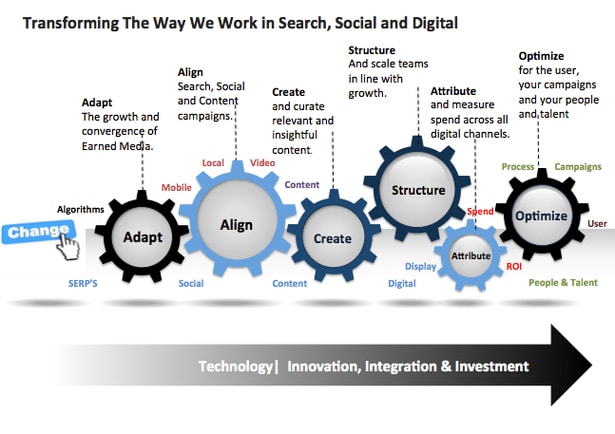
People
Innovation, regardless of how wonderful it is, can’t be successful without having an audience that accepts your ideas. You also have to be able to influence a change in behavior.
In 1962, professor Everett Rogers wrote a book called Diffusion of Innovation that explained how, why, and at what rate new ideas spread through cultures. When it comes to accepting and adopting innovation, Rogers said that the people in every society and industry can be divided into five different groups, broken out as follows:
- Innovators – 2.5%
- Early Adopters – 13.5%
- Early Majority – 34%
- Late Majority – 34%
- Laggards – 16%
When it comes to positioning yourself (or your company) as a thought leader, you have to understand how to identify, engage, and influence those who lead the pack — the Innovators and Early Adopters — and to inspire the Early Majority to follow suit.
The Innovators are the first to adopt new ideas they feel make sense, and to move industries (society) in the direction of their vision. They’re willing to take risks and adopt new ideas, even though they may fail. They lead the bleeding edge.
Hot on their tails stand the Early Adopters. This group has the highest degree of opinion leadership among all of the groups. While similar to the Innovators, they prove more discrete in their choices because they realize that careful decisions will help them retain their leadership position. They’re driven by a vision and are willing to rely on gut feelings when an idea can’t yet be backed by proof.
As innovation moves to the Early Majority and beyond the impact diffuses. This is because others are coming into the mix and trying to replicate and imitate popular ideas, rather than contribute insightful, original opinions of their own. This clutters the conversation, creates noise, and confuses and frustrates audiences – especially customers. I call this the innovation paradox.
Process
As you create your thought leadership strategy, it’s not enough to plan topics and then distribute them. You have to understand how ideas evolve to meet the needs of a more demanding and less risk-adverse customer base. Think of the leaps and bounds Innovators and Early Adopters have taken with mobile technology, and you’ll recognize that innovation doesn’t always mean product. More often it means business and delivery models.
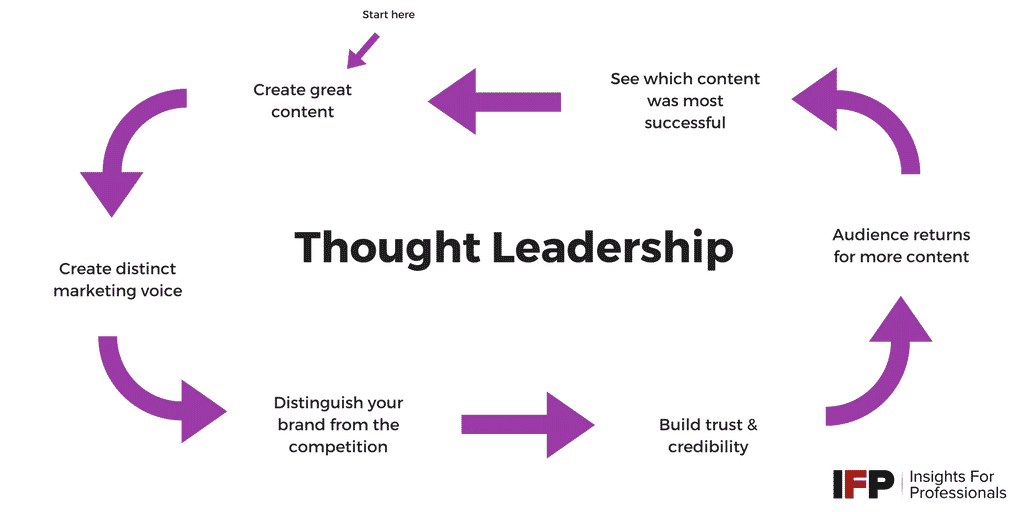
If you don’t know where to turn or where to start, just as yourself: “If I were in my customer’s shoes, what advice would I be looking for?” This will open your eyes to the bigger questions that they have about where their industry – and business in general – is going. Now, work forwards and backwards from where you are today and where your customers need to be tomorrow.
That’s what you do for them, you articulate a vision of what a different future could look like and then you become that trusted advisor that helps them get there. And that, ultimately, should be the impetus of every thought leadership strategy.
Thought Leadership best practices include brainstorming, publishing, and seeing what works. Some ideas don’t always resonate. I once said that HR is the new Marketing to a room full of CMOs and they looked at me like I was crazy. So I refined the message. Tested new ideas. Then I wrote a book about it!
Thought Leadership Tactics
OK, so how do we define the list of ideas, tactics we need to deliver on the promise of thought leadership? And what tools and technologies do we need to support the thought leadership strategy.
One of my favorite ways to brainstorm for clients is to google an important trend or a newer topic in an industry and then search for the latest news on that topic. This approach led me to combine the ideas of “Crypto” and “Defi” to a technology client’s desire to centralize their product strategy. They thought it was brilliant. But I was just following the trail where it led me.
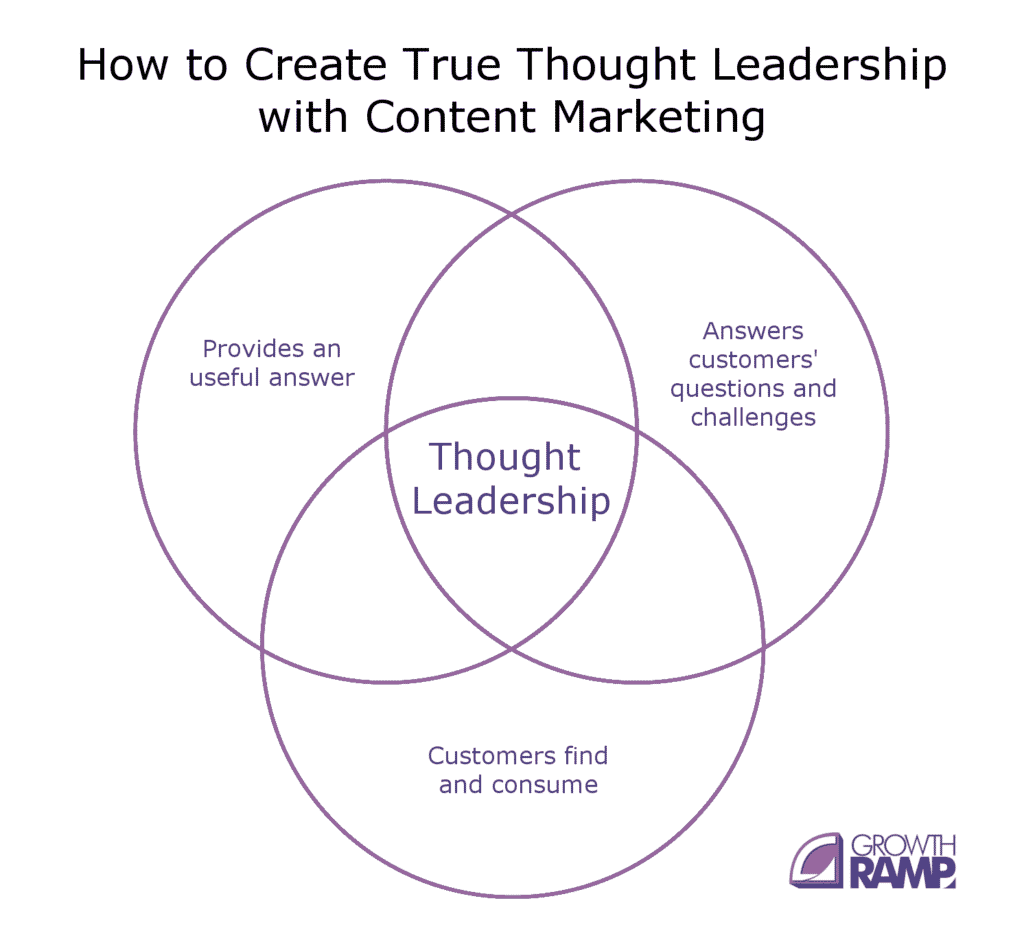
Thought leadership needs to answer a customer question or solve a customer challenge first and foremost. It has to provide a useful and actionable answer. And it needs to be created and published with enough frequency to be found.
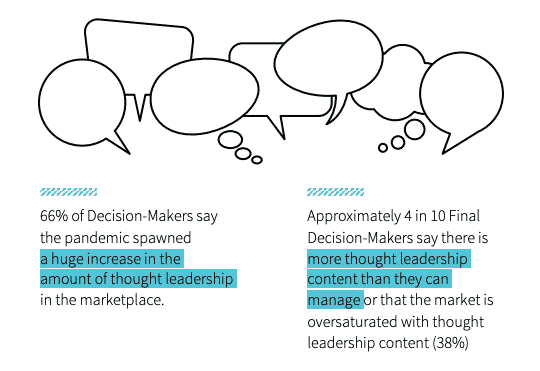
The research from Edelman and LinkedIn show that:
- 66% of decision-makers see an increase in the amount of thought leadership being published.
- 40% say it is more than they can read.
- 71% believe that less than half of the thought leadership they see is valuable. HOWEVER,
- 48% awarded business to the organization due to their thought leadership
- 53% increased the amount of business they did with a thought leader organization
- 71% of decision makers use thought leadership to stay up to date on the latest trends
This is the paradox I mentioned before. Create too little thought leadership and your great ideas will never reach anyone. Create too much and you run the risk of over-saturating your audience. Create poor thought leadership and you lose people. So how do we create thought leadership that solves this problem?
How To Create Thought Leadership That Drives Innovation
In order to earn trust in today’s era of fake news, thought leadership content needs to follow a few best practices. It needs to be authentic, human, thoughtful (obviously), it also needs to come from the good intention of helping your industry or audience. Our bullshit meters are high. And we won’t tolerate blatant self-promotion.
So in looking into innovative thought leadership examples that work, we found the following core best practices.
- Find and celebrate your innovators. Organizations that actively seek and recognize their innovators are more likely to create a culture of innovation that becomes a virtuous cycle.
- Activate your employee thought leaders. Companies that ask their thought leaders to create and share what they know are significantly more likely to create authentic and consistent innovative thought leadership programs vs one-off pieces of content.
- Create multiple paths to test (and learn) new ideas. According to Strategy+Business, only 8% of company leaders have the desire to share their ideas. But creating multiple venues for their participation increased the odds of their contributions by many factors.
- Use insights to drive the strategy. Here at MIG, we use keywords and search queries and a whole lot of brainstorming to create annual content plans for our clients.
- Measure thought leadership success. Using metrics such as website views, search rankings and other metrics are great tools. But at the individual level, do your leaders get asked to speak at events is one great measure of individual success. We even use the LinkedIn Social Selling index (image) to help leaders see their improvement. In one program we saw an 60% increase in the score when they created and shared their ideas and learnings.
Want to Drive Innovation and Growth With Your Own Thought Leadership?
Thought leadership that delivers growth and innovation is not easy. But we can help.
If you are ready to get measurable growth by becoming an authority in your field with quality content published consistently, check out our weekly content marketing service.
Set up a quick consultation, and I’ll send you a free PDF version of my books. Get started today – and generate more traffic and leads for your business.

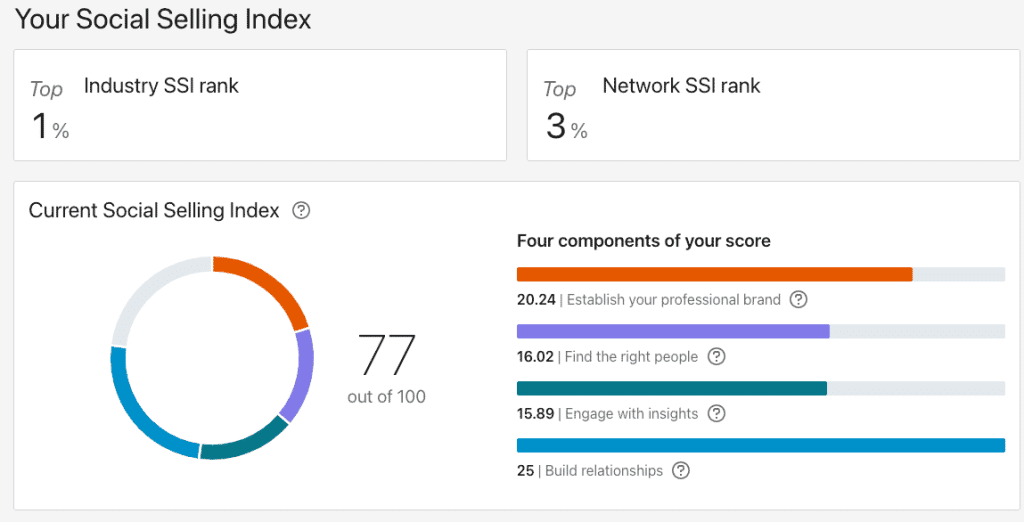
![How to Create Effective Thought Leadership Content [Examples Included]](https://marketinginsidergroup.com/wp-content/uploads/2023/09/Screenshot-2023-08-29-at-11.07.57-AM.png)




